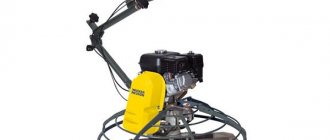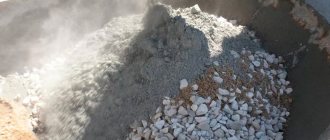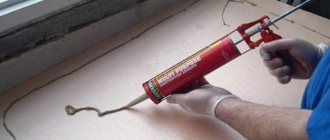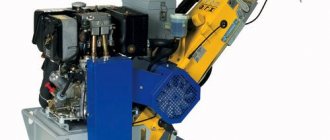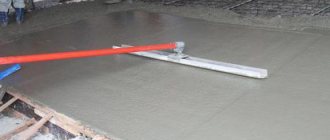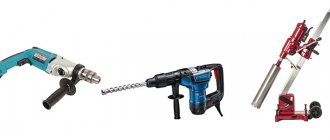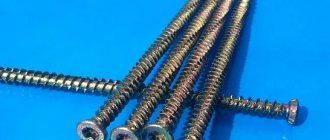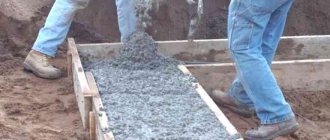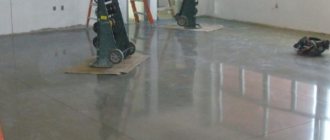How often have you encountered the problem of attaching objects to a concrete surface? This labor-intensive process sometimes frightens even specialists. Make holes of the required depth, insert a dowel, then hammer it in with a hammer or screw it in with a screwdriver... Only a few professionals know about a more simplified and faster way of working. The key device for this method is the concrete gun.
Purpose
This device is only gaining popularity, but there are already various offers of this product on the market, which greatly facilitates installation work. Concrete guns are an excellent option for those who constantly deal with construction work. This is especially true for those who work in difficult conditions. Let's find out why it is necessary to give preference to concrete guns?
First, let’s figure out what a “nailer” is, which is also called a “painting gun”, and also what is it needed for? This device is an automatic nailing tool. With its help, nails are driven in automatically with minimal use of muscle force.
The design and firing system of mounting pistols are almost no different from the design of firearms, which allows them to be produced in weapons factories. Nailers are used both in construction and in industry. In construction, they are often used during repairs and finishing works. As for industry, driving equipment is used here, for example, in the manufacture of containers or packaging.
Return to contents
Device and characteristics
The construction pistol, based on its name, is reminiscent of the firearm of the same name in its body design.
Some types have a similar operating principle to weapons (powder version).
The tool is based on a piston, which, under the influence of external force, pushes out the fastening element at high speed.
The energy source can be electricity, compressed air, or even powder gases.
Principle of operation
All mounting guns are based on the same operating principle - sharp pushing of the fastener by a piston using the energy of an external source (compressed air, flammable gas, powder cartridge).
The simplest pistol must be manually loaded and cocked after each shot.
At the same time, automatic or semi-automatic devices are capable of not only independently loading fasteners from the built-in magazine, but also providing automatic ejection of the cartridge case (powder version) and independent cocking of the mechanism.
Material
The working part of the tool is made of durable metal, while the body can be either metal or plastic.
Some models have a rubberized coating on the back of the handle for more comfortable work.
Dimensions and weight
The ease of use depends on the weight and size of the gun.
Depending on the design and type of tool, it can weigh from 1.5 kg to an impressive 5 kg or more.
Its length directly depends on the length of the fastener for which it is designed.
Suitable sizes of nails and dowels
The instructions for each tool clearly indicate what size fasteners it can work with.
Also, the appropriate types of fastening elements must be specified there, and in the case of a powder pistol, also the types of cartridges used.
The dimensions of the fasteners are always selected in accordance with the base material to which the fastening will be made.
Wood-only tools have less power, but nails whose length exceeds 20cm can be used.
Guns for metal require dowels of shorter length, however, they should be chosen taking into account the fact that they must penetrate well through.
Tools for concrete are the most powerful, so the manufacturer produces fasteners for this material that can withstand titanic impact forces while maintaining their functionality.
As a rule, it is relatively short, but has a large thickness.
Guns capable of piercing concrete will also be able to pierce brick, since the latter has less hardness.
Advantages and disadvantages
Compared to the manual method, this method has a number of advantages. Characteristics of the mounting gun:
- does not damage the surface (no dents or chips are formed);
- requires less labor, time, and physical stress of the employee;
- works without a power supply, which allows it to be used in the most extreme situations;
- guarantees virtually complete absence of injuries;
- allows you to secure the thinnest and most delicate parts;
- increases productivity;
- Great for installing drywall.
This list is not exhaustive. Nailer also has other advantages. There are also disadvantages, but their insignificance makes them noticeable only when characterizing a single instrument.
Return to contents
Kinds
There are several classifications of concrete guns. Depending on the cartridge feed, there are:
- single-shot (manual feed);
- semi-automatic (with cassette-disc feed);
- automatic (with cassette feed).
However, the most common classification of nailers is their division into 4 types:
- pneumatic;
- gas;
- powder;
- electric.
In construction, the first three categories are most often used.
Return to contents
Construction guns for different types of work
In addition to mounting guns designed for driving in dowel nails, there are also various types of these tools that can be used to carry out a wide range of construction work.
These include guns that are used to apply sealant, glue, or grout joints.
A caulking gun is a tool that squeezes out a compound from cartridges that is designed to seal something. Its operation is based on the movement of a piston, which, acting on the bottom of the cartridge, squeezes out a certain amount of sealant.
Based on the type of compartments in which the cartridges are located, such pistols come in sheet and frame types, with the latter being the most popular. They hold sealant containers well.
Depending on the method of squeezing out the composition, these tools are:
- rechargeable, the advantage of which is autonomy;
- electric, which operate from the network and are designed to work with different cartridges;
- pneumatic.
In the latter version, the material is squeezed out under the influence of air when the handle is pressed. As a rule, such guns have an ergonomic design and various devices for regulating and limiting the release of sealant, making them very convenient to work with.
A construction glue gun has a very simple principle of operation: a rod with an adhesive composition is placed in a metal chamber, where it is heated using a thermoelement connected to the network, and after pressing the trigger, molten glue is squeezed out through the nozzle.
Using such a gun, you can glue surfaces made of plastic, glass, metal, wood or leather, join strips of linoleum or fiberboard sheets, repair shoes or assemble broken porcelain, seal, decorate or model something.
A construction grouting gun is an indispensable device for jointing brickwork, clinker and other types of ceramic tiles. It makes it possible to reduce material loss, maintain the cleanliness of the treated surface and accurately fill seams without voids and air bubbles.
Using certain types of these guns, you can not only facilitate the performance of various construction and installation works, but also carry them out quickly and efficiently.
A mounting gun is a tool designed for quickly driving dowel nails into concrete, thin steel, brick or stone. This equipment allows you to work much faster than with pre-drilling a hole and then driving in conventional dowels. This tool belongs to the professional category. It has a higher price than classic installation equipment, but when working on large-scale projects, its use is more than justified. The operating principle of this equipment is similar to a nail gun (nailer), which is compatible only with nails. This is a fundamental difference with a mounting gun, which works with dowel nails.
Pneumatic nailer
This pneumatic device is the most famous and in demand among specialists. The number of its varieties allows you to cope with any type of work.
Advantages of an air gun for concrete:
- simplicity of design is the key to durability and reliability of the pneumatic unit;
- high speed of work, which allows you to increase its productivity several times;
- the compactness of the device allows you to store it in any convenient place;
- the lowest price per shot, which is ideal for budget-conscious buyers;
- easy-to-understand instructions for maintenance and use, which allows you to cope with almost any type of work without outside help;
- relatively quiet, with the least impact during installation work.
Disadvantages of this category of pistols:
- compressor required;
- connection to the electrical network is required;
- The compressed air hose interferes with operation.
Pneumatic mounting gun brand Hilti.
An example is the Hilti pneumatic mounting gun. It is used on various surfaces, ranging from silicate, steel and ending with plaster masonry. When naming the advantages of this unit, it should be noted:
- high speed;
- the attached parts adhere securely and efficiently to the surface;
- no dust or exhaust gases are generated during operation;
- ability to adjust the power of the shot.
The most significant disadvantages are:
- high shot volume;
- limited access to service centers;
- the relatively high price of consumables, which is explained by their originality.
Return to contents
How to use a sealant gun: instructions for a beginner
Beginners and craftsmen who picked up a sealant gun for the first time, following the instructions described above, can easily prepare the tool to begin work. You need to purchase a complete gun and, according to the recommendations, install a tube in them. Otherwise, you need to learn to control your hand so that the pressing occurs smoothly and the material yields evenly and in doses.
When using half-body and skeleton pistols, you need to perform several presses at the beginning so that the substance from the inside enters the cap. Then ensure smooth pressing when the sealant is already coming out.
When using cordless and electric pistols, pressing the trigger regulates the flow rate of the composition. Beginning craftsmen need to choose places that are invisible to the eye for their first work: in the far corner, behind furniture, under plumbing fixtures, and so on. After your hands get used to working with such a tool, you can move on to visible places.
If the sealant does not fit well into the seams or it needs to be leveled, you need to wet your fingers in water and smoothly remove the imperfections. The substance has a sticky consistency and can remain on the hands and stick to the fingers. The material does not need additional drying; if you provide fresh air, it will have time to harden in a few hours.
On video: Rules for using a sealant gun
Experienced craftsmen adhere to a certain strategy in their work. But they, just like beginners, will find some tips useful:
- For one-time work, you can choose more affordable types of pistols, such as half-body and skeleton-shaped.
- You need to know that high-quality and reliable tools are heavier. Since it is not possible to check the functionality of the tool in advance, it is necessary to pay attention to this aspect.
- Universal options are considered to be case models, which are also well suited for permanent use.
- Guns can be used to fix sealants purchased in soft packaging. You need to remove the fixing nut from them and remove the upper spout, then place them in the device body, trim the upper part with a knife, and then return the removed parts to their place.
- Usually, the manufacturer who produces sealants in tubes marks the optimal place for cutting on the spout; you can use the instructions provided.
To reduce substance consumption, you must follow these recommendations:
- Pre-prepare the seam to be processed, clean it of dirt, moisture and degrease.
- The remaining areas of the surface that do not need to be treated can be isolated with construction tape.
- You must try to squeeze out the substance in such a way that the seam line on the surface is not interrupted.
- You need to wait until the substance has completely hardened, and only then remove the auxiliary stickers in the form of adhesive tape or masking tape.
The gun is an indispensable attribute for applying sealant during repair and construction work. It provides convenience, and sometimes ease, uniformity, and economy of application of the substance. Therefore, it is very important to understand the algorithm for working with a sealant gun before starting work.
Sealant gun, how to use it correctly (2 videos)
As you know, a device designed to work with sealant is called an applicator and has an appearance similar to a gun or syringe. All instruments are divided into amateur and professional. In any case, despite the intensity of their use, this is either a mechanical device or its pneumatic modification.
Types of sealant guns
Household pistols for home use are exclusively mechanical, and their design is different, since this affects the service life of the tool. For sealant packaged in foil, use a cylindrical gun. If it is located in a cartridge, then it can be applied using a pressure gun, which is structurally designed like a large syringe. If you purchased the sealant in a bucket, then you do not need a gun; it is enough to have a spatula or trowel for the job.
There are several types of pistols: manual with a cylindrical body; manual skeleton; pneumatic.
Manual with a cylindrical body is the cheapest and short-lived; it breaks after using one or two tubes. It is extremely inconvenient to work - the rod moves poorly, the cartridge tries to “escape”.
A manual skeleton gun costs a little more, it is more comfortable to use and more durable, and the movement of the rod is smooth without distortions. The most reliable and convenient is a tubular gun (syringe). In it, the sealant is ideally located inside, there is no movement, and the rod moves easily and freely. This design can work with sealants contained in bags.
Pistols are divided according to the type of cartridge compartments, and are classified into sheet and frame. It should be noted here that sheet guns fix the cartridge body worse than frame guns. Before purchasing, it is important to determine how easy and comfortable the pistol is in your hand. It is advisable to press the trigger several times to feel whether the brush is comfortable to use. Separately, it is worth paying attention to reliability; as experience shows, models with handles and a trigger lever made of molded aluminum are lightweight and quite durable.
The pressure screw is the simplest device for squeezing out sealant. Non-reverse pressure guns are most often used professionally. It is more convenient to work with this tool because the piston moves exclusively in one direction forward until the sealant runs out. But when you know in advance that a small amount of sealant will be needed or you know about a break in work, then you need to use a gun with a reverse stroke, which allows you to stop squeezing out the sealant at a certain stage of the work. In this case, after completing a little work, the cartridge is removed from the compartment, the tip is closed and stored until the next use. You should also pay attention to the expiration date of the material; often expired sealants are the cause of leakage in the filled joint.
Professional guns include pneumatic and cordless tools. The time between failures of these devices is long and lasts several years. Air guns operate using compressed air and are driven by a trigger. Many models are equipped with a pressure regulator. The most expensive gun is a battery-powered one, which has the ability to adjust both the pressure and the rate of supply of sealant. This model is very easy to use; you just need to release the handle and the sealant flow starts immediately. It is universal and suitable for both tubes and bags.
How to use a caulk gun
Not many of our compatriots know how to use this tool. Let's learn how to properly use a caulking gun. To begin with, it is enough to have a cylinder or cartridge, as well as the gun itself, which consists of three main parts: a frame, a pusher and a trigger. So, the sequence of actions is as follows: 1. pull out the pusher as far as it will go; 2. take the sealant, cut off the plastic tip on which the markings are indicated; 3. pierce the membrane, which is located under the plastic cap, with a suitable object; 4. securely insert the tip into the intended hole; 5. press the latch, pushing the pusher until it stops in the hole in the bottom of the cylinder.
When using a “syringe” gun, you need to unscrew the ring into which the spout is inserted, then remove the inner insert and place the spout in the desired place. By pressing the compensation lever, we pull out the rod as much as possible. After this, cut off the metal ring from the bag and screw the ring onto the spout. Upon completion of work with the gun, it must be rinsed with warm water.
And finally, a few nuances in working with a pistol.
- 1. To properly apply the sealant, the application site should be free of dust, dirt, oil, old paint, rust and loose particles. 2. Widen the narrow crack a little and clean it with a brush. 3. Prepare a spatula, masking tape, and alcohol. 4. Degrease the surface to be applied with alcohol. 5. Then you should treat the working surface with an acrylic primer for good adhesion of the sealant.
How to apply sealant efficiently?
To ensure that the seam is even, you should use the following recommendations. It is better to cut the top of the cap of a tube with sealant using a stationery knife at an angle of 45°, so that the diameter of the resulting hole matches the actual size of the seam. Next, lightly press the trigger so that droplets of silicone appear from the hole in the tube. To apply the sealant evenly, it is necessary to hold the gun at the same distance from the wall. Filling should not be done quickly so that you do not end up with broken strips with air bubbles inside. The creation of a beautiful seam occurs thanks to masking tape glued to both sides of the gap, which is removed immediately after applying the sealant along with its excess.
There is another way to perform a high-quality, especially fillet weld. To do this, you need to carefully moisten the side surfaces with soapy water. It is necessary to prepare a wooden or plastic stick in advance, one side of which is cut off in such a way as to set the shape of the future seam. In this case, the final formation of the upper part of the seam is created not by the nose of the tube, but by the passage of the above stick along it. If it happens that you squeeze out excess sealant, then it’s not at all scary; after drying the seam with a hairdryer, you can remove all the remaining sealant from the side surface with the same stick washed in soapy water.
Did you find this article helpful? Subscribe to site updates to receive the latest articles about renovation and interior design before anyone else!
Gas nailer
The main feature of this category is high mobility, as well as independence from power supply. This unit works due to the energy of the explosion of a mixture of gases and air, due to which the piston moves.
Advantages of a gas gun for concrete:
- thanks to its high power, the device can be used even on the hardest surfaces, such as concrete, when installing metal dowels;
- minimal expenditure of physical strength allows you to work longer;
- ease of use (no hoses, wires);
- compactness and lightness (up to 4 kg of weight);
- to work with this version of the nailer, no special permits are required, which makes it possible to work in various construction institutions;
- accessibility to maintenance and use without various difficulties;
- versatility, suitable for all types of construction work.
The disadvantages include the following:
- exhaust gases that are formed during work lead to the need to ventilate the room;
- periodic cleaning of the combustion chamber is required;
- relatively high cost of the unit.
Gas nailer Spit Pulsa 700 E.
One example of a gas nailer is the Spit Pulsa multi-charge model. This is one of the most expensive units, but its quality justifies the price. This gun allows you to work with various types of surfaces, which is achieved through operation from a battery and a gas cartridge. The high power of this device is also complemented by the ability to automatically regulate the force of the shot.
This unit is used both for work on concrete, brick, wood, and profile plasterboard (narrow-profile model 700 R). However, its practicality and attractive appearance do not bring it much demand. The high price of consumables is beyond the means of many users.
There are also cheaper models of gas nailers, namely Aiken pistols. Compared to Spit Pulsa and Hilti units, the Aiken MGN 850C Gas concrete mounting gun has its own characteristics and advantages. Among them are:
- installation with increased safety;
- availability of service centers and their accessibility in all cities;
- efficiency - one charge is enough for 4 thousand shots;
- ability to change consumables.
There were also some downsides. Unlike Hilti brand pistols, this unit has a weaker blow, an additional battery and other disadvantages. However, Aiken is the most affordable and widespread among buyers.
Return to contents
Types of mounting guns for driving dowels
The tool discussed in this article can be presented in several versions, which differ fundamentally in the system that creates the force that drives the fastener into solid material. Depending on the principle of operation, the following mounting guns for dowels are distinguished:
— gas;
— pneumatic;
- gunpowder;
- electric.
Let's consider each option in more detail, taking into account the nuances of use, advantages and disadvantages.
1. A gas construction gun is a model that has an impact piston mechanism, which is activated by the explosion of a small portion of gas supplied from a special connected cylinder. The force of the explosion is transferred to the dowel and this energy is enough to almost instantly drive a metal fastener (pin, nail, dowel, etc.) into a solid material.
The advantages of such a construction and installation device include:
— lightness of the tool even in a charged state;
— absence of hoses, cables, wires and absolute independence from the presence of electricity;
— ease of operation;
— high impact power, which allows for direct installation work;
- multifunctionality. Gas mounting guns can replace a screwdriver or hammer drill.
In addition to the advantages, these models also have some disadvantages:
— the high price of each shot, which is due to the high cost of the gas mixture;
— it is necessary to ensure constant ventilation or ventilation of the room when working with a gas gun;
- considerable cost of tools and consumables.
2. Pneumatic construction guns are devices that operate on the expansion energy of compressed air pumped by a special compressor. This option is very popular among consumers.
Attention! For normal operation of the air gun, it is necessary to constantly maintain the average value of the supplied pressure within the range of 5.3-7.2 bar!
The pneumatic device is a little inconvenient to use, since a dense hose is connected directly to the mounting gun, supplying pressurized pressure. It somewhat limits possible movements and movements, however, modern models do not have this inconvenience and their air ducts are flexible and light. Continuing to list the disadvantages of the device, we can highlight its dependence on the availability of a source of electricity. If there are no working outlets nearby, it will not be possible to work with an air gun. Although, new modern models have special rechargeable batteries that ensure stable operation of the device for approximately 46 minutes.
Powder nailer
Powder mounting gun SPITFIRE P370.
The use of this device has been going on since Soviet times. This pistol uses the same operating principle as a firearm. The piston is driven by a special cartridge charge, the firing force of which depends on the hardness of the base.
The following advantages are characteristic of a powder mounting gun:
- high power, which allows you to carry out work on any surface (shot energy can reach 550 J);
- autonomy (works only on cartridges);
- small size and relatively light weight;
- lack of batteries, wires, hoses and compressors;
- a wide range of nails, the use of which depends on the purpose.
Among the disadvantages, the following factors should be noted:
- Use of this device requires permission;
- high price for cartridges;
- Sometimes cleaning and replacement of some parts is required.
Common models of this type of nailers are pistols of the SPIT and SPITFIRE brands.
Return to contents
Features and scope
The construction gun is designed for driving dowel nails into concrete, reinforced concrete, brick, stone, steel and other hard surfaces.
In appearance, the tool is similar to an ordinary pistol or a small jackhammer. It is used in the installation of electrical and ventilation equipment, various pipelines, roofing, plumbing and many other construction and installation works. Its operating principle is based on the use of special cartridges, the cartridges of which are painted in different colors, indicating the charge level.
The dowel gun is quite easy to use. Thanks to its maneuverability (it does not require a power source), it ensures the installation of fasteners in the most inaccessible places, regardless of any weather conditions.
Electric nailer
Electric nailer Rapid.
Their use is most often associated with finishing, since work is carried out on the smallest parts (for example, studs). This category is characterized by the presence of a battery or connection to the network. An electric concrete gun has the following advantages:
- the cost of one shot is relatively low;
- light weight, compactness, as for network devices;
- autonomy, as regards battery-powered devices;
- relatively quiet during operation, no vibration;
- no exhaust gases are generated;
- accessibility of use and maintenance.
However, this unit has a number of disadvantages:
- insufficient power to work on a hard surface (the limitation depends on the size of the consumable - up to 65 mm);
- depends on power supply;
- inability to use in places with high humidity or explosion hazard;
- low speed of shots (about 1 shot per second);
- quite high cost of the unit.
For example, we can cite devices from the Rapid and DeWalt brands.
Return to contents
